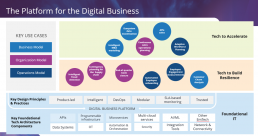Last year we predicted that “70% of CEOs of large European organisations will be incentivised to generate at least 40% of their revenues from digital by 2025, driving more than €4 trillion of gross value added in Europe.”
As we approach 2023, do we expect this to change?
If anything, the trend has accelerated. According to IDC’s Digital Executive Sentiment Survey (October 2022), European organisations now expect more than 50% of their revenues to come from digital business models on average in the next three years.
Listening to C-level executive priorities for the coming year, it’s clear that despite the polycrisis macroeconomic scenario, the C-suite remains optimistic about future digital investments and is increasingly looking at technology as a critical business differentiator to better deliver business outcomes, increase resilience and accelerate revenue growth. According to the chief innovation officer of a transportation company: “For the next six months our priority will be to build capabilities, including bringing people onboard, to help us build digital products.”
This is the dawn of a new digital decade — the digital business era. But even if the “what” is clear, the “how” is somewhat less clear.
There is urgency, particularly in Europe, to connect technology investments and revenue generation. The majority — 61% of European organisations — take a very siloed and disconnected approach to software projects. This results in one-off or reactive software innovation efforts that only occur in response to urgent market or customer demands. More often than not these efforts do not have a positive impact on revenue generation.
To succeed as a digital business, we argue that companies need to leverage a digital business platform. IDC defines this platform as a multilayered enterprisewide technology architecture, integrating different systems and applications, to enable use cases that ensure business competitiveness and innovation. Only 13% of European organisations have such an architecture, according to IDC’s Digital Executive Sentiment Survey, October 2022.
The platform can be segmented into 3 main layers:
- Foundational IT. These are the key tech building blocks forming the foundational tech layer required to deliver digital products and services. This includes 12 main elements: APIs, data systems, automation and orchestration capabilities, OT technologies, microservices, programmable infrastructure, multicloud services, security, AI/ML and other emerging technologies (blockchain, AR, VR, robotics, edge, etc.), integration tools, network and connectivity. Some digital design principles and practices should guide the CIO in implementing the right digital architecture.
- Tech use cases to build business resilience. These are specific digital products that enable the company to remain competitive, responding to the key business challenge of building resilience. This includes use cases that future-proof business, organisational and operations models such as contingency planning for the supply chain and customer churn analysis.
- Tech use cases to accelerate business growth. These use cases to accelerate growth and innovate include ecosystem data monetisation and intelligent M&A modelling.
As organisations build out their digital business platforms, this paves the way for business outcomes such as:
- Expanded target markets through innovative partnerships
- Extended digital use case road maps
- Greater opportunity to diversify the business model
- Greater loyalty/reduced churn with both customers and employees
If you want more information, reach out to Giulia Carosella, Neil Ward-Dutton, Jennifer Thomson, Mark Child, Andrew Buss, Archana Venkatraman or Tom Vavra.




